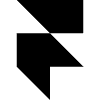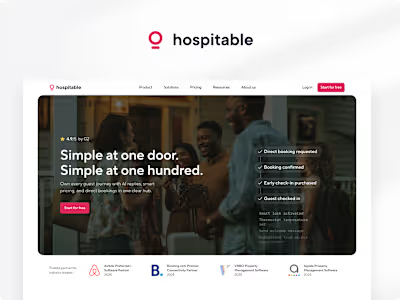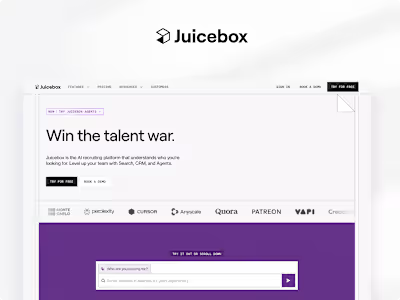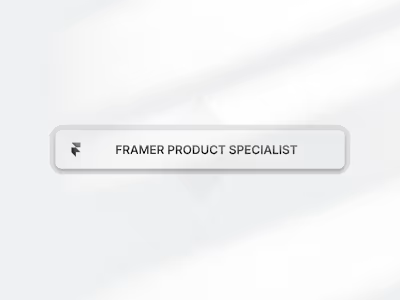Built with Framer
How I earned the 50k badge as a Framer developer
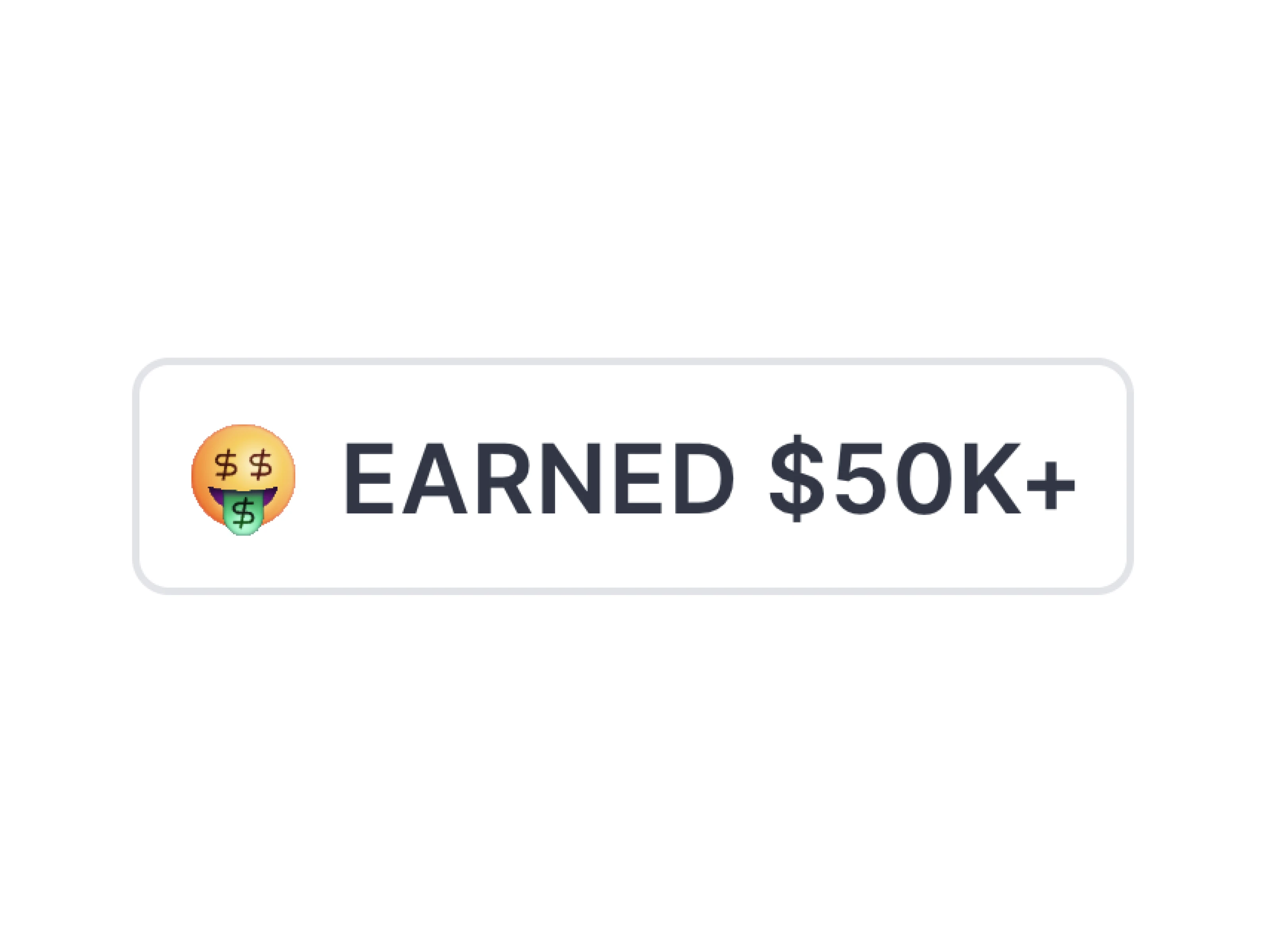
Hey there! 👋🏻
If you’ve ever felt lost trying to figure out how to start freelancing — or wondered whether it’s actually possible to go from zero experience to making a living online — this one’s for you.
I’m not here to sell you a course, promise overnight success, or tell you that there is some magic trick that only I know. Instead, I want to walk you through exactly how I went from having no clients, no network, and no clue... to building a freelance career I’m genuinely proud of.
This isn’t a guide, and I’m not claiming I have it all figured out. It’s just my story — everything that worked, everything that flopped, and the hard lessons I picked up along the way. Hopefully, by the end, you’ll walk away with a clearer picture of what the early days of freelancing really look like (hint: it’s not always pretty, but it’s worth it).
Let’s get into it 👇🏻
Structure
This is a pretty long read, so to make things easier, I’ve split it into two main parts:
My story – A chronological breakdown of how I went from zero clients to making a living as a freelancer.
Lessons I learned – A bunch of practical takeaways and insights from the journey, especially useful if you’re just getting started.
Feel free to skim through or jump straight to the parts you care about — I won’t take it personally 🙂
Here's also a nice table of contents for your convenience 👇🏻
Structure
My story
Discovering freelancing
First steps
Valley of despair
Outbound → Inbound
My first paying client
Twitter, 2nd client, and FT job
The breakthrough
Overdeliver, build your portfolio, and repeat
Lessons
Client acquisition
It takes longer than you think it will, but then it happens all at once
Don’t raise prices if you are not ready
People will ghost you
Hourly projects aren’t the enemy
Be relationships-first
Communication is key
Build your Contra profile
Get the word out there
You don’t need to be a salesman
Know your bottleneck
Take action
Free goodwill
My story
Discovering freelancing
My [freelancing] journey starts in the summer of 2023, right at the end of my high school years. Everyone - parents, teachers, classmates, you name it! - wanted me to go to university, and for a while, I thought I wanted it too, but deep down, I knew that I actually didn’t care; I just wanted a nice career that could allow me to live a nice lifestyle.
I watched any video you can think of about making money online. Still, all the models sounded too risky for an 18-year-old kid. After searching for a while, I finally stumbled upon the idea of freelancing - selling your service to multiple businesses instead of just one. The idea sounded appealing; no risks involved, and no upfront capital required, so I got sold.
I picked making websites as my service because I knew HTML, CSS, and JavaScript from high school, so I figured that would be the most frictionless way to get started. However, it didn’t take me long to figure out two things:
Most people want to pay the same guy to both design and develop a website, especially small businesses
Nobody wants a hard-coded website; people value the ability to make changes themselves
This seemed a bit daunting, but I was full of myself, so I decided to go online and learn both of these skills completely by myself. I learned design using a couple of random web design ebooks I found online and a course from Flux Academy [my first “business expense”]. Then, I picked a no-code tool to build these designs, which ended up being Framer.
First steps
Way before I was any good at making websites, I figured people wouldn’t trust me without any proof of my work, so I decided to work for free in exchange for a couple of portfolio pieces and testimonials.
NOTE: If you are part of design Twitter, you’ll know there’s some controversy on the topic with people saying: “Never undervalue yourself!!” - but look at the reality of the situation: you have no experience, no real work done, barely know what you are doing, and you think someone will pay for it? Maybe you’ll find someone - but it’s not gonna be easy.
The first thing I tried was reaching out to a few people in my network who I thought may have needed a website. You know, like people with a brick-and-mortar business but no website. Things didn’t really go as planned, and I got 0 clients from this 😭
The next idea I got was to go on Discord, find a random work-related server, and offer my service there. I found one, went into the job board, and made a post saying that I would design and build a site for free in exchange for a testimonial.
To my surprise, within a few hours, I got quite a few messages. That was my first sign of real progress! Out of all the messages, I got two people who were serious about it:
A guy with a similar age to me who wanted to start a 3D-animations service
A guy who wanted to start a SaaS
I set out to design these two landing pages, and in a week or so, I was ready to show my progress to the clients. The second guy took the Figma file and just disappeared, while the other guy actually valued my work and asked me to build it in Framer - and so I did. Another week passed, and the site was ready, so I handed it off to him, and he was super happy! So happy that we actually ended up becoming fairly good friends and now check in with each other every so often.
Now that I had two testimonials, I thought I was ready to get my first real client.
Valley of despair
By this time it was around July and I had finished my exams, so now I was seasonally working in a tobacco shop here in my town. I was so determined to make this work that I would wake up every day at 5 am to get a couple of hours of work in before going to work [the enthusiasm only lasted a few months, I now wake up around 10am lol]
Thinking that things were about to get easier, I purchased a freelancing course to discover how to get real clients and decided to apply things exactly as they were taught. The method in question was “cold” emailing, so I purchased a domain to look a bit more professional and started sending out emails using the scripts provided.
The scripts needed quite a lot of personalization, so I would hand-pick Instagram people I could reach out to [mostly small fitness influencers] and then send them an email. Finding potential prospects, validating them, and then sending out emails became harder and harder [as there are only so many small influencers], so at best I could reach out to around 5 people per day.
Remember when I said I thought things were about to get easier? I was so mistaken.
In two months of DAILY [yes, including weekends] cold emails, I barely got any replies, and they were all NOs. Things looked a bit dark as I had just given up my whole summer to try and get this to work, and I was still at square zero.
Doubting my strategy’s effectiveness, I kept researching how to improve my script - yet nothing ever worked. After two months finding potential prospects started to become hard, so out of desperation, I tried emailing Italian fitness influencers [I had stayed away from the Italian market because here people don’t really value a website that much] and also decided to again offer my website for free, hoping that more social proof would eventually help me.
To my surprise, it only took a couple of weeks to get my very first call with a prospect! I really can’t describe how happy I was to get on a call after three months of absolutely no results.
So, I got on the call, explained what my idea was, and he agreed on getting the free site in exchange for a testimonial 🥳 I started working on the site in September, and the site went live around mid-October. During the whole summer, I kept improving my design and Framer skills, so I actually delivered a decent site, and the guy was stocked about it!
He kept his word and left me a 10/10 video testimonial that gave me a big boost in confidence! I still wanted to try to use cold emails for client acquisition as people in the course were having success with it. I kept doing it for a couple more weeks while trying to leverage the work I had just done, but things didn’t work once again, so I just threw in the towel and decided to try something new.
However, my seasonal work had ended and I was weighing on my parents’ shoulders, so I also started sending out curriculums to get a filler job while I was figuring freelancing out. There’s not much to discuss here apart from the fact that it took me forever to land a job, so from October/November to March I was basically unemployed, which meant I could focus entirely on freelancing [while spending a couple of hours each day giving out curriculums and attending interviews].
Outbound → Inbound
Outbound was clearly not working for me, so I decided to try inbound [aka, getting eyes on your work and waiting for clients to get in touch with you]. My strategy was:
Build a portfolio and get traffic via SEO
I actually knew nothing about SEO, so I started learning things online and applying them on my site.
Create a profile on Contra
And get verified as an official Framer expert
Both of these things required me to have a portfolio, but I didn’t want to waste time on anything that wouldn’t bring my work in front of people, so I got a free template from the marketplace, edited it a bit, and called it a day.
The first thing I did was set up my Contra profile, upgrade to pro, and get that Framer expert badge I desperately wanted. I thought that’d be the key to getting inbound clients that were looking for a Framer developer - but I was, once again, mistaken. It took me two months to get my first client from it [more on this in the next chapter].
In the meantime, I started investing in SEO. I built a basic blog and started writing about anything related to websites in the hope that would get me some traffic. This never worked till I started writing about Framer, which was a niche with basically zero competition, so I finally got a few visitors per day going. I also started building a few free resources, which did pretty well in the community.
Looking at other people on Contra, I saw they were pricing their services more than I could have thought possible, so I tried to mimic them and set my prices at:
$3k for a landing page
$5k+ for a full website
Obviously, this failed miserably because I had nothing to back up those prices, but at that time, it sounded like a good idea.
My first paying client
In December of 2023, after months of hard work, I still had earned $0 from my freelancing endeavors. I was a bit discouraged, but I knew [hoped] I was this 🤏🏻 close to starting to make money from it, so I kept going.
One day, it finally happened. I got my first ever inbound message on Contra! It was from an Italian guy around the same age as me with a little AI startup that was blowing up. They had a site already built in Framer but had decided to interrupt the collaboration with their previous developer, so they needed someone else to make small changes here and there and also build new pages/sections when necessary.
I wanted to get the job so bad that I decided to go the extra mile: I studied their site, found issues it currently had, and prepared a list that I could bring up during the call. The call was stressful, and I wasn’t sure I would get the job, but at the very end of it I brought up the list I had created, mentioned it to him, and he was really happy with it and thanked me for it.
Maybe I’m wrong, but I do believe that going the extra mile with that list showed I wanted the job and made a good impression on him.
A few days later he got back to me with the good news: I had gotten the job! After months of hard work, I was finally about to make my first dollar online. Getting this job was a massive win for me, as it showed I could actually make it!
So, I rushed to an accountant to get registered as an official freelancer/solo company and then started working for them. The tasks they gave me were small and quick, so in a couple of months of collaboration [Dec & Jan] I only made around $300 dollars, but that was more than enough to fuel me to persevere on my path!
Twitter, 2nd client, and FT job
The Framer community was growing rapidly, and people were looking for support. The team wasn’t yet as fast as they are now, so people would have to wait a bit to get an answer to their questions. So, to get my name out there, I decided to spend a few hours daily in the community to help other people solve their Framer issues.
After a month of doing so, I got my second paying client! The guy had some performance issues on his site and asked the community for help; I did a free audit and proposed a few solutions, which were a bit too technical for him, so he asked me if I could handle it - to which I, of course, said yes!
It was a small, $150 gig - but the guy was super nice and very happy with my work, so he hired me two more times between February and May, leading me to almost hit $1k from freelancing!
In February, I also decided to start posting on Twitter. Engagement was flat to say the least, but unknowingly I was setting the foundations for one of the biggest growth factors in my story.
In March, after a few months of searching, I finally managed to find a FT position. It was a simple, remote position as part of a web development agency - and my role was to basically fill out pre-made websites with content. The job wasn’t bad, and the fact that it was remote made all the difference, as it meant that the minute I clocked out, I could go back to working on my freelancing adventure.
With a full-time job taking up most of my day, things started to slow down a bit, but I tried my best to be consistent with blog posts and Twitter postings. A couple of my articles and resources unexpectedly did pretty well and allowed me to get out of that zero-engagement nightmare on Twitter, gain my first couple hundred followers, and - more importantly - get known in the community.
Being the only one with a little SEO and performance knowledge among designers gained me some visibility and allowed me to carve out my little sub-niche, which would soon lead to the biggest breakthrough in my career.
The breakthrough
May of 2024 marked my first year as a freelancer-wannabe, yet I still had to make my first 1k from it. However, in May 2024, two major things happened that changed the course of my journey dramatically:
I was hired as a freelance Product Specialist at Framer
Framer was expanding his Product Specialists team, and thanks to my little blog and the SEO insights I was sharing on Twitter, I got on their radar. After an “interview” with the head of the customer success team, I landed the job as a contractor with 18 hours per week - which paid me well enough to allow me to quit my job.
I landed my first “big” freelance gig - a 3k Figma to Framer project
This happened randomly when one evening a friend of mine - who was also active in the Framer community - DMed me on Twitter saying he had recommended me in the community job board. If you are not familiar with the job board, it’s usually low-quality gigs, so I didn’t have a lot of hope - but I logged in and saw he had a nice budget so I thought it would be nice to land it. However, it already had 10+ comments, so again I wasn’t that confident I would have landed it.
Unexpectedly, just a few minutes later, the guy - who turned out to be an agency owner - DMed me saying that, among the candidates, I looked like the best pick and asked me if I was interested! I immediately accepted and, after signing an NDA, I set up a project in Contra and started working on this.
Thanks to the security my Framer job provided, I handed in my notice at my FT job, and at the end of May, my contract there also ended. After one year of struggles, I was finally making a living as a freelancer!
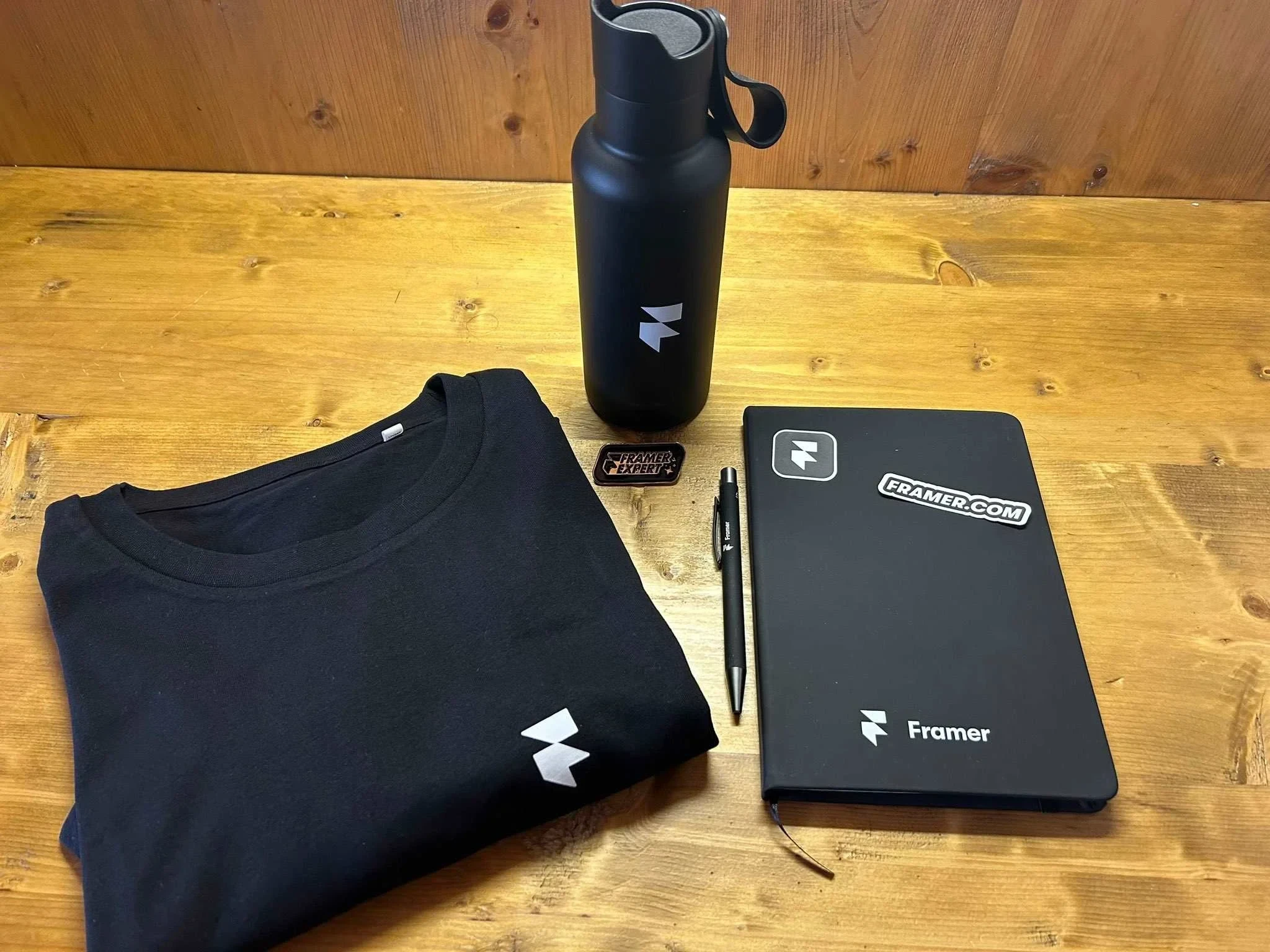
Framer swag pack
Overdeliver, build your portfolio, and repeat
The agency owner I mentioned in the last paragraph was really happy with my services, and during the summer, he gave me a few other gigs that allowed me to make around $500-$1000 per month, which, together with Framer work, resulted in around 3k per month during summer.
All of these deals, together with the previous ones, were handled via Contra. Even though I only had received one client through the platform in around 9 months, I was still a big believer in building a public profile with reviews/numbers/projects backed by a third party - which looks much more trustworthy than what you claim on your portfolio.
In July of 2024, the work I put into the platform finally paid off, and I received the “top independent” badge, which is a badge the team assigns manually to freelancers who stand out for their work quality, responsiveness to clients, reviews, etc. This was pivotal for me as it significantly boosted my position among Framer experts, which in less than a month allowed me to land three projects:
An SEO audit for a Framer website
A small website design and development project
My biggest project yet, an 8k website design and Framer development
This was a big milestone in my journey, as it finally gave me the confidence to start charging what my services were actually worth
At this point, I was fully booked, yet Contra was still bringing me prospect after prospect, which eventually led me to turn my availability off, as I could no longer take clients. Again, this gave me a big boost in confidence, as it was my very first time having so much work that I had to turn down new offers.
From this point on, there’s actually not much else worth discussing - once you get momentum, things become really easy. The period between September 2024 and February 2025 [when I got the 50k badge], looked basically the same:
Overdelivering on the projects I was working on
Keep posting on my blog & Twitter profile to build credibility
Updating my Contra profile every so often, and just turning my availability on whenever I needed new clients
Slowly raising my prices
☝🏻I’ll touch more on these points later
And that’s basically it from my story! Let’s now look at the lessons I learned on my way here :D
Lessons
Client acquisition
The first thing I want you to know is that client acquisition will look significantly different when starting out compared to when you are more established. On Twitter, you may hear people suggest “start a Twitter account!”, “share your work online!” or “Just overdeliver, referrals will come to you!” - these are all very valid suggestions, and I can now confirm they work amazingly, but they have one problem: they are SLOW.
Building a following on Twitter works, but it will take months before you have a decent following.
Sharing your work also works, but again, getting eyeballs on it can be really hard and time-consuming.
Referrals work wonders! But only if you have past clients that can refer you.
When you are starting out, do anything it takes to get your first few clients. If you read my story, you’ll know that I used these methods to find my first few clients:
Cold emails
Helping people in the community
Applying to job boards
These are the ones that worked for me, but there’s a million others you can try:
Letting your network know that you now offer this service
Doing design roasts and sending them to the website owner
Reach out to agencies/studios to see if they need help
Cold calling
Reach out to local businesses with broken/outdated/no website
Create profiles on as many freelancing platforms as possible [I 100% suggest Contra, but you can give a try to Upwork, Fiverr, PeoplePerHour, etc.]
Create templates and offer to customize them [this only worked for me once, but I never really pushed it]
In general, the more proactive the approach, the better.
Once you have 5-10 projects under your belt, your portfolio will be looking strong, and - if you do a great job with your clients - you’ll soon start getting referrals, and you will get to a point where client acquisition is no longer a problem.
It takes longer than you think it will, but then it happens all at once
When I first started out, I thought I would get to 10k/mo within a few months because the YouTube videos I had watched made me believe it was easier than it sounded. The reality? Things always take waaaaaaaaayyyyyy longer than you think they will, and for the majority of the time you’ll see no results and doubt whether you are actually doing the right thing.
In my example, it took me one whole year to go from 0 to $3k per month - but it wasn’t linear progress. For 11 out of the 12 months it took me, I was averaging less than $100 [yes, one hundred] dollars per month, then all of a sudden, my income jumped to $3k/mo.
The hard part about the journey is that you don’t know how long the first part will take, and you will constantly doubt whether you are spending time on the right things.
Don’t raise prices if you are not ready
This is the mistake I see most often. If you don’t have a good reason to, do not raise your prices. If you are struggling to find new clients, then raising prices is not the solution.
As a rule of thumb, don’t raise your prices if you are not fully booked.
I would rather charge a bit less and be booked than charge too much and struggle to get any work.
People will ghost you
I've lost count of how many times I got a message from a potential prospect, replied back showing interest, and then got ghosted.
In the beginning, I would get discouraged, but with time, I learned to let go, as this is perfectly normal.
Following up with them is ok - people are busy and notifications can get lost. But I usually just let it go - people who ghost you are not clients you want to work with.
Hourly projects aren’t the enemy
“Never charge per hour, or you’ll be penalized for being fast!!”
Is this good advice? Absolutely.
Should you apply it as a beginner? Absolutely not.
Out of the 50k I made in the past nine months, around half of that was from hourly projects. Don’t be fooled by online advice; you can make very good money from getting paid hourly. Assuming a $50/hour rate and a 40-hour workweek, you should be able to average around $8k per month with it - that’s very good money!
Also, if you are struggling to find work, do not turn down a prospect because he wants to work hourly. In the beginning, you should take what you can get your hands on - don’t get picky before you can afford to walk away from a deal.
Be relationships-first
If you were an employee, would you prefer a manager that is nice to you or that treats you like garbage? They will both pay you the same, but the experience on the job site will be totally different.
Now, if you were a client, would you prefer a freelancer who is nice to work with or who ghosts you all the time, only cares about money, and forgets about you once the project is over? Assuming they both deliver the same quality in the same timeframe, which one would you choose.
We both know the answer.
Being GENUINELY nice and friendly will never detriment your freelance career. In the short term, it may look like you are wasting some time that you could spend somewhere else, but in the long run, you’ll cultivate a solid network that will be worth more than you could ever expect.
Communication is key
Do not confuse communication with reliance.
If I’m working with a designer, yes, I want to be updated on what is going on; yes, I want to be involved in important decisions, but no, I don’t want him to give me more problems to solve. That’s his job!
Your job as a freelancer is to take problems off the place of your clients, not shove more of them on it.
Make sure to regularly update your client on what’s going on, but try to be as independent as possible.
Build your Contra profile
Building my Contra profile is probably the best investment I’ve made since I started freelancing.
I kid you not, but when I turn my availability on, I start getting one or two high-quality prospects PER DAY! As you can imagine, it doesn’t take long before I’m fully booked. In fact, between September 2024 and April 2025, I only had to set myself to be available for two weeks to get as many clients as I needed to be booked all these months.
Now, if you read my story you know this wasn’t always the case. In the first 10 months on Contra, I only got one client for a total of $200. Then I got around 1k in inquiries in a span of two months. And then suddenly, an 8k project came my way, and from there I never struggled with Contra again.
It’s mostly a winner-take-all situation. Those at the top get all the leads, while those at the bottom barely get any - and this is true for any freelancing platform. You can hate the game and complain about it, or you can put in the work to build your portfolio and get among those who get all the leads. The choice is yours.
Get the word out there
Nobody knows you exist at all, let alone knowing you can build them a good marketing website.
Get as many people as you can to know who you are and what you do, and opportunities will eventually come your way.
This can mean building a social media following, posting your work in as many places as possible, letting people you meet know what you do for a living, and so on. If they know what you do, you’ll probably be the first one they think of when they need you.
Every conversation is a chance to sell, softly.
You don’t need to be a salesman
When I first started out, I would get overwhelmed as soon as I heard the term “sales”.
I would hear people talk about scripts, objections, frameworks, etc., and I would just feel hopeless. Speaking in English was already hard enough for me as a non-native, let alone following scripts and handling objections.
Now, after tens of calls, let me tell you something: you don’t need to be a salesman to sell your service. Knowing the basics of sales and psychology will absolutely help you, but I guarantee you it’s not as hard as it sounds.
Most of my calls nowadays look like this:
Initial chitchat to break the ice and get to know the prospect
Ask why they want to design/build a site on Framer
Define what they expect from me
Ask about budget
Say I’ll get back to them with an offer
And that’s literally all there is to it. 99% of the time, people will already know you before they hop on a call with you [be it for your portfolio, content you posted online, someone told them about you, and so on], so you don’t have to do any crazy convincing.
Just ask what they want, make sure you can actually help them, and if you can just show conviction that you can indeed help them - and that’s all you have to do.
Know your bottleneck
Constraints theory teaches us that a system is only as strong as its weakest link.
If you are great at your skill but can’t get any clients, you don’t need to practice more - you need to get people to know you.
If you are good at getting clients but people aren’t happy with the service you provide you don’t need better clients - you need a better service.
If you are good at both of the above but can’t get anything done in a day, you don’t need to outsource - you need better time management.
Stop for a second, reflect on what’s holding you back, and then spend the majority of your day fixing that part.
Take action
"But surely every man is his own god: Fortune refuses her aid to those who merely pray, and take no action." - The fall of Icarus, Ovid
Nothing of what we discussed so far will matter if you don’t actually put yourself out there. Learning about something is a good idea but practicing is what will get you results.
Your first 100 posts will teach you more about posting than any course you could take.
Your first 100 calls will teach you more about sales than any book you could read.
Your first 100 sites will teach you more about web design than any ebook you could ever buy.
The road is longer than you think it will be, and preparing for it can only take you so far - start now and thank yourself later.
Free goodwill
And that’s a wrap! I hope you found this little article helpful. If you did, the only thing I ask is a quick like — it helps more people in the same situation discover it and (hopefully) get some value from it too.
No newsletter signups, no popups, no strings attached — just a bit of free goodwill. Thanks for reading 🙏
Like this project
Posted Mar 31, 2025
If you’ve ever felt lost on how to start freelancing — or wondered if it’s really possible to go from zero to making a living online — this one’s for you.
Likes
228
Views
3.5K

